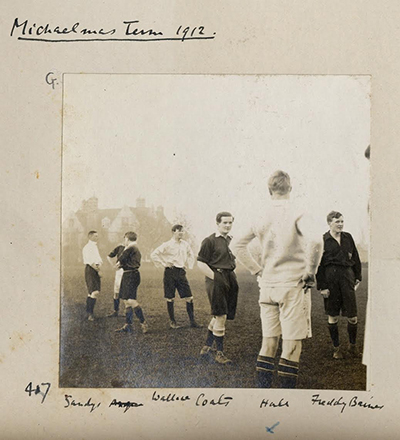
Alan Wallace, fourth from left, at football practice in 1912 during his first term at Balliol College.Image: Balliol College, Oxford.
An article about Alan Wallace before he left for Oxford in 1912 as a Rhodes Scholar noted that he had ‘not had opportunity to show all that is in him; but he has the elements of greatness’. Unfortunately, that sentiment would endure as within three years this ‘tall, strong and comely’ young man was dead from a sniper’s bullet at Gallipoli.
Auckland and Oxford
Wallace was a model student and athlete, and at age 20 was the youngest Rhodes Scholar yet chosen from New Zealand. He entered Auckland Grammar School as a Foundation Scholar in 1903, where he won numerous prizes, predominantly in mathematics, science, and languages. He enjoyed several unbeaten seasons with the 1st XI and 2nd XV, and the headmaster described him as ‘a lad endowed in no ordinary degree with moral and intellectual force’. He received a Senior District Scholarship, a Senior National Scholarship, and entered Auckland University College (AUC) on a Junior University Scholarship, in which he was second in the Dominion.
His academic achievement continued unbroken at AUC from 1908, where he earned Senior Scholarships in pure mathematics, mechanics, and chemistry and was awarded the Sir George Grey Scholarship in chemistry, mathematics, and astronomy. The professor of chemisty, T.D. Brown, praised Wallace’s laboratory research at the College as ‘differ[ing] so much from that which commonly occupies the undergraduate’. Wallace was awarded his M.A. in 1912 and went on to study mathematics at Balliol.
Wallace’s athletic talents were most prominent on the cricket pitch. The Auckland University College 1st XI relied heavily on his batting prowess from 1909-1912, and he ‘saved his side from disaster’ on multiple occasions. He was ‘steady and consistent’ when batting, and managed to ‘slog’ a century during a match with Victoria College during the 1911–1912 season. Wallace represented Auckland in interprovincial cricket matches for two seasons. He made his representative cricket debut in ‘good style’, accumulating 72 runs in a match against Hawke’s Bay at Victoria Park on 3 March 1911. He was also ‘a useful Association footballer, a strong swimmer, handy in a boat, and a good shot’.
Alan Wallace was born in 1891 to George and Florence Wallace and grew up on Lake Road, Devonport, where his father was the first manager of the Devonport Gas Works. His brother Bertram also died in the War, at the Somme, France in 1916. Bertram Wallace also attended AUC and is recorded in the Roll of Honour as a non-matriculated student.
Wallace was quiet and unassuming, and did not seek popularity. His reserved exterior hid a ‘great social charm, plenty of humour, and a sharp but goodnatured wit’. He involved himself in the life of Auckland University College as an officer in societies such as the Students’ Association, the Men’s Common Room Club, and the Cricket Club.
At Balliol College, Wallace found that ‘Nature and Art have combined to make Oxford and its surroundings almost ideal for all forms of athletic exercises’, and he enthusiastically embraced the sporting culture there. Although the summer term of eight weeks seemed too brief for tennis and cricket, the spires, towers, and gables poking into the ‘soft blue sky’ among the ‘trees clothed in luxuriant green… could not be more perfect’, and Wallace found the matches there ‘delightful’. The bicycle had long been a near-universal form of transport in Oxford, and Wallace enjoyed seeing the first signs of spring as a cyclist.






